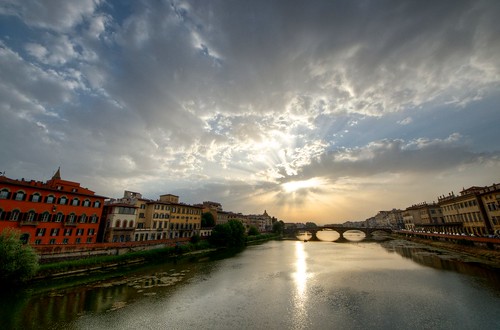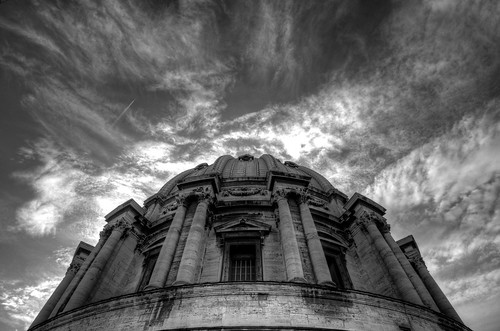I have just come back from a trip around Italy, and I had a lot of fun shooting photos and working on them straight away, so I would like to share something about my workflow on the road.
In past trips I used to travel preferably with my iPad only, while this time I decided to take my laptop. This was mainly due to the size and weight of the MacBook Pro; now I have a MacBook Air 11", which to be honest does not feel much bigger and heavier than the iPad…
This is the software I installed on the machine:
- Aperture 3: The keystone of the entire workflow;
- Photomatix Pro: I love HDR, and I have always been using this amazing application. To be honest I have not tried many other competitors in this area, I did choose Photomatix in 2005 when I started playing with HDR and the software always got me covered;
- Photoshop CS5: Mainly used to stitch multiple photos (i.e. panoramas, removing moving objects, etc.);
- DxO Optics Pro: I have a lot of fun with my Sigma 8-11mm ultra-wide, DxO makes it very simple to fix the geometry, distortions, and improve the images in many ways;
- Noise Ninja: I haven't used Noise Ninja much since I bought the Nikon D7000, but it's always handy when I need to shoot at very high ISO and heavy noise is visible (on the D7000 I only use it above ISO 12,800).
In addition to this, I use Geotag Photos on my iPhone, great application to get GPS data and geotag all my photos.
I need to say that I am amazed of what can be achieved with such a small machine as the MacBook Air (especially since I have the 2010 Core 2 Duo version); although the computing power is quite limited, I was able to do all post processing that I wanted, and the laptop kept the pace nicely, without generating much heat either.
Basic Workflow
After a day of visiting and shooting, I take the SD card out of the camera and import the photos using the Aperture importer. I usually shoot in RAW+JPG, to keep all options open in post-processing, although I must say that I really like the way Aperture develops RAW files, so I might stop shooting JPG in the future. As soon as the photos are imported, I go through all of them in full screen, to do a first quick rating: Aperture makes that very easy, you can simply hit the keys from 1 to 5 to rate a photo with the corresponding number of stars. In general I consider everything with at least a 3-star rating to be worth post-processing, I keep the 2-star "just in case," and I delete the 1-star photos. During the first review of the photos, I sort them by date, and I organize the linked images in stacks (i.e. multiple exposures to be merged in HDR). After the review, I change the sorting method to show best rated photos first. In this way I spend the little time I have for post-processing focusing on the strongest shots.
Backup
Everybody who knows me would tell you that I am quite paranoid regarding backups. One of the things that scares me is when all copies of the data are in the same place: at home I use CrashPlan to backup remotely, but while traveling the amount of data is too big and good Internet connections too rare for that to be effective, so I have to rely on local hardware. I backup data in two ways:
- Apple Time Machine with an external USB hard disk: whenever possible, I do not store the Time Machine HD in the same bag as the laptop, in case I lose one bag;
- Aperture Vault on a USB thumb-drive, which I keep always in my pocket. I use a 32GB drive for this, and I have not yet shot more than this in a single trip.
Geotagging
Geotagging is very important for me, I like to know exactly where I was when I took a particular shot. As mentioned earlier, I keep "Geotag Photos" running on my iPhone, and when I'm back at the hotel in the evening I get a GPX file on the laptop, and I use that to geotag the photos with Aperture "Places" feature. If you need some more information on how to use Aperture to geotag photos, or other help on Aperture, I recommend you listen to this excellent tutorial by Don Mcallister.
Post-processing
To avoid taking up too much disk space, I try to do the maximum I can directly in Aperture: all round-trips in other applications take a lot of disk space, especially if you use expensive formats like TIFF-16.
I don't think the plugin architecture is mature enough yet, or maybe it's just the plugins that I am using which are not mature, either way when I like a photo I prefer to export it, process it out of Aperture, and import the result back. This is especially true for HDR: Photomatix standalone application gives many more options than the Aperture plugin; furthermore, whenever I shoot a lot of bracketed photos, I tend to group them, carefully process one set, save the settings in a preset, and process the rest in a batch. This is very convenient when I am traveling and I don't have the computing power of my Mac Pro available. I can launch all the batches and let them run when I'm not around. A similar approach is also good with DxO Optics, which allows you to configure the work using a fast preview, and then to start the processing of all the photos.
Depending on the type of processing, I choose a different export format from Aperture. DxO works better with RAW files, while I don't think Photomatix development module is as good as Aperture's, so in this case I export TIFF-16 files.
Sharing
I tend not to wait to get back from a trip to share the best photos (unless I can't find a good Internet connection). I usually share on flickr first, and from there to Twitter and Facebook. The exception is Google+, where I upload the photo instead of posting a link to flickr. For flickr, the Aperture exporter is usable, but very often I use FlickrExport, far more flexible.
Back home
When I get back from a trip, I simply import the Aperture library in my main library, and I usually group the various project in a single folder. Aperture is very flexible when it comes to importing and exporting projects and libraries, as it is on organizing your photos.

